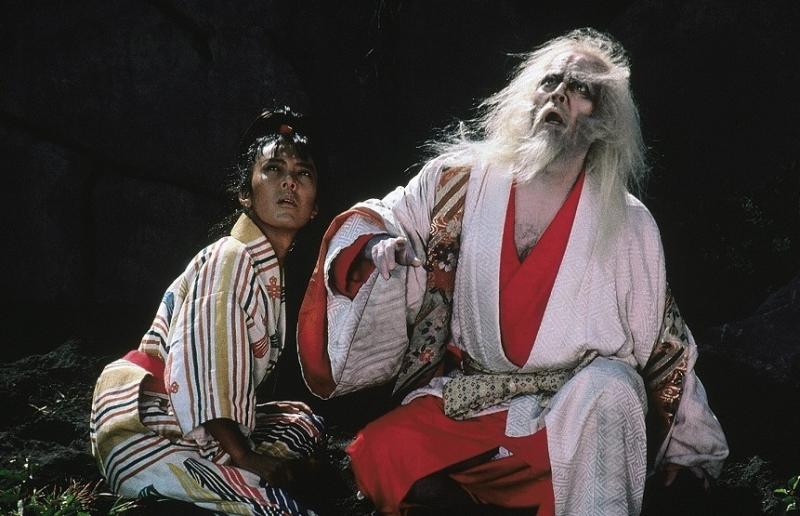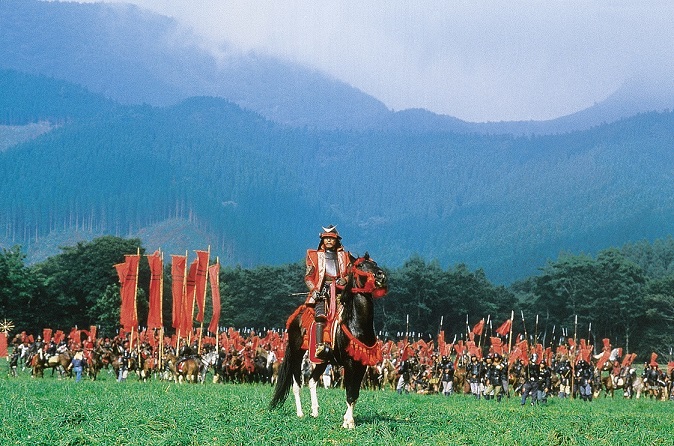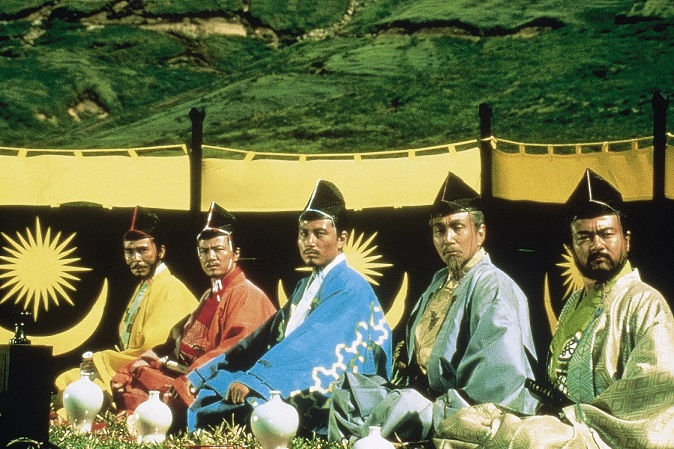Ran | reviews, news & interviews
Ran
Ran
Kurosawa's Lear-inspired epic of the futility of war restored to visual glory

Even by the varied experiences of transferring Shakespeare to another culture, with the attendant revelations that come when an original story is modified to match a world governed by very different priorities, Akira Kurosawa’s Ran is virtually in a class of its own.
Instead his direct inspiration was the story of a 17th century feudal lord, whose three sons proved themselves exemplars of virtue in striving to protect the interests of their clan, the polar opposite of the bloody division that follows when Ran’s hero Hidetora announces his decision to divide up his kingdom. The device of the three arrows that accompanies the ruler’s initial division of his heritage – individually, they are easily snapped, but prove much more enduring when held together – came from that legend.
Kurosawa’s epic plays out against gloriously grand landscapes
But the Lear parallels inevitably came to the forefront in the film’s development, though the differences that Kurosawa chose to emphasise in his treatment become almost as revealing as what he took more faithfully from Shakespeare. The samurai honour code brings its own extra dimensions that make Hidetora-Lear’s loss of the trappings of power all the more devastating, while Kurosawa’s treatment of the fool (Shinnosuke Ikehata, an actor associated with comedy, has an almost androgynous presence: main picture, with Tatsuya Nakadai as Hidetora) and the blindness theme adds original elements. No less powerful is the final revelation that the scheming of Lady Kaede (Mieko Harada), who becomes a far more demonically prominent figure than any of the Shakespearean husbands, is shown to be in itself revenge for her own family honour slighted a generation earlier.
Another element that distinguishes him from Lear is that Hidetora is, above all, a warlord, one whose power has been achieved through conquest, so that we see in the bloody conflict of his downfall, with its raining arrows which seem to darken the sky and literal streams of blood, the conclusion of that earlier rise to glory. The massed battle scenes are hugely grand as spectacle – no computer special effects here, rather a cast of close on 1,500 extras; they also catch a pivotal change in the history of conflict, when the appearance of firearms for the first time in Japan altered the traditional course of battle whch had been dominated until then by cavalry (parallels with nuclear weapons, and their devastating employment in Japan only decades earlier, were somewhere in Kurosawa’s mind). The closest translation of the original Japanese title is “chaos”, the sense of which grows incrementally despite all our sense of hierarchical rank and strictness of military formation.
 The main sense in which Ran differs from its Shakespearean prototype must be the sheer sense of scale of its setting (pictured above). If we think of Lear as a dark and stormy play, Kurosawa’s epic – for Ran really does fall into that category – plays out against gloriously grand landscapes that are almost a character in themselves, none more impressive than the enormous rolling mountains with which it opens. The visual spectacle is compounded by the colour-coding of the armies of the three sons into yellow, blue and red (pictured below), as their ranked banners fly against the huge skies.
The main sense in which Ran differs from its Shakespearean prototype must be the sheer sense of scale of its setting (pictured above). If we think of Lear as a dark and stormy play, Kurosawa’s epic – for Ran really does fall into that category – plays out against gloriously grand landscapes that are almost a character in themselves, none more impressive than the enormous rolling mountains with which it opens. The visual spectacle is compounded by the colour-coding of the armies of the three sons into yellow, blue and red (pictured below), as their ranked banners fly against the huge skies.
Shakespeare really was in Kurosawa’s blood, with the former’s sense of philosophical pessimism crossing boundaries of national consciousness as much here as in the director’s (aptly tited) Macbeth adaptation, Throne of Blood. We may be aware of the traditions of Noh theatre in the performances of Tatsuya Nakadai as Hidetora (a role originally intended for Toshiro Mifune) and Harada as Lady Kaede, whose increasingly perverted presence comes to dominate the closing of the film, but they play out in accordance with the rest in the same way that Toru Takemitsu’s Mahler-inspired film score blends with the film’s distinctive natural soundscape.
 The cinematography (Kurosawa typically worked with three cameras) is sometimes almost mind-blowing, full testament to a budget at its time the largest the Japanese film industry had seen (a coproduction partnership with France proved crucial), and this 4K restoration, marking the 30th anniversary of the film’s original release in the UK, accentuates all that visual glory.
The cinematography (Kurosawa typically worked with three cameras) is sometimes almost mind-blowing, full testament to a budget at its time the largest the Japanese film industry had seen (a coproduction partnership with France proved crucial), and this 4K restoration, marking the 30th anniversary of the film’s original release in the UK, accentuates all that visual glory.
No less remarkable then is the thought that, for all his film’s grandeur, Kurosawa may have been really thinking of himself, and his own rather stymied film career when he embarked on what would become one of his undisputed masterpieces (even if it was not generally appreciated as such on its release). "Hidetora is me," the director once mused, leaving us to ponder how much this huge film was inspired by Kurosawa's own life as it was by Shakespeare's drama.
Subscribe to theartsdesk.com
Thank you for continuing to read our work on theartsdesk.com. For unlimited access to every article in its entirety, including our archive of more than 15,000 pieces, we're asking for £5 per month or £40 per year. We feel it's a very good deal, and hope you do too.
To take a subscription now simply click here.
And if you're looking for that extra gift for a friend or family member, why not treat them to a theartsdesk.com gift subscription?
more Film
 The Problem With People review - local zero
Hardly a Forsyth saga, this unfunny Oirish comedy is a homage to catatonia
The Problem With People review - local zero
Hardly a Forsyth saga, this unfunny Oirish comedy is a homage to catatonia
 Anora review - life lesson for a kick-ass sex worker
Sean Baker's bracing Palme d'Or winner twists, turns, and makes a star of Mikey Madison
Anora review - life lesson for a kick-ass sex worker
Sean Baker's bracing Palme d'Or winner twists, turns, and makes a star of Mikey Madison
 Blitz review - racism persists as bombs batter London
Steve McQueen's overwought World War Two boy's adventure film delivers its message
Blitz review - racism persists as bombs batter London
Steve McQueen's overwought World War Two boy's adventure film delivers its message
 Small Things Like These review - less is more in stirring Irish drama
Cillian Murphy is exceptional as a man wrestling with his church and conscience
Small Things Like These review - less is more in stirring Irish drama
Cillian Murphy is exceptional as a man wrestling with his church and conscience
 The Room Next Door review - Almodóvar out of his comfort zone
The Spanish director's meditation on mortality is a beautiful misfire
The Room Next Door review - Almodóvar out of his comfort zone
The Spanish director's meditation on mortality is a beautiful misfire
 Blu-ray: The Outcasts
A forgotten Irish folk horror is eerily magical and earthed in the soil
Blu-ray: The Outcasts
A forgotten Irish folk horror is eerily magical and earthed in the soil
 London Film Festival 2024 - Nickel Boys, crime and punishment and Ukraine
Colson Whitehead's Pulitzer-winner adapted, a Belgian serial killer, Chinese odyssey and sexist Indian police in our final round-up
London Film Festival 2024 - Nickel Boys, crime and punishment and Ukraine
Colson Whitehead's Pulitzer-winner adapted, a Belgian serial killer, Chinese odyssey and sexist Indian police in our final round-up
 London Film Festival 2024 - a shaman and sham
Warren Ellis saves wildlife and himself, Pavement go post-modern in two music docs
London Film Festival 2024 - a shaman and sham
Warren Ellis saves wildlife and himself, Pavement go post-modern in two music docs
 Documentary highlights from the 2024 London Film Festival
A close look at insightful new non-fiction films about single motherhood, visionary photographers, scam artists, legacies of colonialism, and more
Documentary highlights from the 2024 London Film Festival
A close look at insightful new non-fiction films about single motherhood, visionary photographers, scam artists, legacies of colonialism, and more
 Venom: The Last Dance review - Tom Hardy's people-eater bows out
Poignancy studs the digital punch-ups as the super-alien saga concludes
Venom: The Last Dance review - Tom Hardy's people-eater bows out
Poignancy studs the digital punch-ups as the super-alien saga concludes
 theartsdesk Q&A: director Jacques Audiard on his Mexican trans gangster musical 'Emilia Pérez'
The French filmmaker concocted an extravagant genre mash-up to confront the tragedy of Mexico's 'disappeared'
theartsdesk Q&A: director Jacques Audiard on his Mexican trans gangster musical 'Emilia Pérez'
The French filmmaker concocted an extravagant genre mash-up to confront the tragedy of Mexico's 'disappeared'
 London Film Festival 2024 - Angelina Jolie does Maria Callas
Plus John & Yoko in New York, Elton in LA and Pauline Black in Coventry
London Film Festival 2024 - Angelina Jolie does Maria Callas
Plus John & Yoko in New York, Elton in LA and Pauline Black in Coventry

Add comment